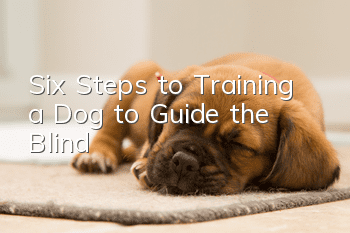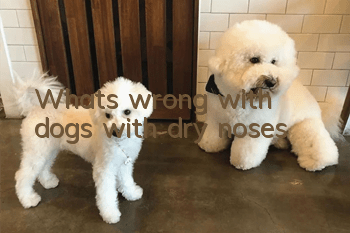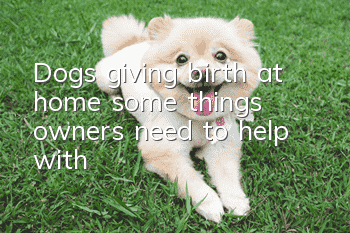Six Steps to Training a Dog to “Guide the Blind”

The dog is trained to correctly guide the blind person to move according to the command of the trainer (or the blind person), and actively stops moving or bypasses obstacles when encountering danger or adverse consequences. In addition, guide dogs must also have the ability to refuse food, help blind people ride in cars, pass items, ignore interference from passers-by, and not attack passers-by and animals. Dogs used for guide training should have a stable personality, be intelligent and lively, docile and calm, have good vision, sensitive hearing, and have good psychological quality and judgment.
The training of guide dogs is generally carried out by professional trainers who imitate the movements of blind people and hold pathfinding canes or wooden sticks. After the dog has learned all the skills, the blind person who uses the dog should learn to master and command it correctly, and personally feed and train the guide dog so that the dog and the blind person can establish a deep relationship and tacit cooperation. In some countries in Europe and America, if a blind person wants to get a guide dog, he should first become a member of the Blind Association, but honorary soldiers or model workers may have priority. Blind people who want to purchase a guide dog must first apply, and generally have to wait about a year before they can get one. In these countries, guide dogs have a red cross sign on their necks and the words "Guide Dog" written on them! Guide dogs are allowed to enter any public places and take transportation. Dog training requires a special "U"-shaped dog leash, which is a "U"-shaped handle made of a metal bent rod with a diameter of 4-5 mm and a length of 100-110 cm. The metal rods are solidly sewn into soft leather or fabric, and each end is made into a buckle for fastening to the dog's collar.
Suitable age: 8 months-0 months
Training objectives: Training in professional courses for the guide blind must be conducted by specialized trainers at specific training venues and public places. The training venue should be equipped with various obstacles: such as small bridges of different widths, blocking poles at railway crossings, steps, entrances and exits simulating station platforms, traffic light signals simulating intersections, and various obstacles. Various blocking posts (height can be raised and lowered), ditches and common cars, etc. During training, the handler should constantly change the placement of obstacles at any time and at any time to prevent the dog from forming a bad association. At the same time, the trainer should educate the dog not to bite various small animals that are close at hand.
Applicable dog breeds: guide dogs | Labradors | Golden Retrievers
Venue: Specific training ground
Equipment: Special "U" shaped traction sheath | Obstacles | Cane
Level: University (Professional)-Professional Skills Training
Training cycle: 45 minutes*30 times
Steps to train a dog to "guide the blind":
No.Step one: For barrier-free flat road training, choose a barrier-free path. The trainer asks the dog to sit on his left side or slightly in front of him. He gently holds the dog's "U" shaped handle with his left hand and holds it with his right hand. Use a cane or wooden stick to find the way, and give the dog the "rely" and "go" commands. The handler and the dog should move forward together, but the dog should not be allowed to pull the handler, but should walk side by side slowly. In the early stage, the walking route should be linear. When the dog can move slowly side by side with the handler, the handler should reward the dog with a "good" command. At the end of the training, a pet or food reward should be given. As the dog's ability to accompany the handler improves, the dog's endurance should be gradually developed, and the distance traveled can be gradually increased to 1 kilometer or more. When the dog is very proficient in the obstacle-free path, it is necessary to make the training environment slightly more complex and develop the dog's turning ability. During turning training, the trainer should first slow down the pace, give the dog a "turn right" or "turn left" command, and at the same time twist the handle with his left hand in the direction he is going, and also turn in the direction and walk slowly with the dog. . When the dog turns its direction, a verbal reward should be given. Repeat training in this way until the dog can completely turn according to the command. During barrier-free flat road training, the handler shall not allow the dog to stop traveling without any reason, but the handler may often make 1-2 actions that cause the dog to stop traveling unexpectedly. After the dog is proficient on the trail, the dog should be taken to the main road or highway to walk, but it must be slowed down to the side so that the dog can completely learn to slow down its walking speed and walk straight and turn side by side with the handler.
Step 2:Obstacle warning training Obstacle warning training is the most important part of guide dog training, and it is also the only way for blind people to regain their sight. Early warning of road obstacles can save blind people from embarrassment, injury or even save their lives. The trainer first places some objects on the road that the dog cannot cross, such as benches, boxes, piles of rocks, etc. During training, the handler gives the dog "reliance" and "go" commands and walks with the dog. When the human dog reaches the obstacle, the handler gives the dog the "stop" command and stops. If the dog stops, tap the obstacle with the cane, and at the same time give the "good" command and pat the dog to reward it. Then, the trainer can lead the dog around the obstacle or have others remove the obstacle, continue to move forward, and repeat the training lesson. Repeat this training until the dog completely masters the ability to stop automatically in front of obstacles that cannot be crossed. When dogs have the above abilities, obstacles must be set in a way that dogs can pass but people cannot, such as various low, medium and high barrier poles. The training method is basically the same as above, that is, the handler, under the guidance of the dog, comes to the roadblock pole and promptly issues the "o; Stop" command. If the dog stops, tap the barrier pole with the cane and praise the dog. If the dog does not stop, the handler should stop immediately and hold the dog while tapping the barrier pole with the cane. , signaling to the dog that although the dog can pass, the owner cannot. After this action, the dog can understand the owner's intention. Repeat the training in this way, and gradually reduce the "stop" command in front of the obstacle. Until the dog guides the handler to stop in front of the blocking pole. At this time, the height of the blocking pole should be constantly changed to cultivate the dog's accurate judgment. That is, if the height of the blocking pole is below 2 meters, the dog should be trained to actively Stop and give warning. If the barrier pole is above 2 meters, the dog will continue to guide the handler. The method is still the same. Initially, when the barrier pole rises to 2 meters, the dog may also stop automatically. At this time, the handler Encourage the dog to continue moving forward. Repeatedly raise the blocking pole to above 2 meters or lower it below 2 meters for training, and strictly implement the stop when you need to stop and go when you need to go. The dog will be able to form a 2-meter barrier in his mind. The dividing line accurately guides the handler's actions. Repeat training in this way until the dog is completely proficient in this skill.
- How long does it take for dogs to be dewormed before all the worms are killed?
- Signs of depression in dogs, come and see if your dog has it
- What should you do when faced with "fungi + mites + inflammation"?
- Select competition-grade Husky puppies based on bone proportions
- Illustration of the correct ways and precautions to greet your dog
- Dogs have dandruff and hair loss
- What to do if Teddy can’t digest dog food
- Will the ancient shepherd dog recognize its owner?
- Does Corgi recognize its owner?
- Can a dog recover after being hit by a car and unable to stand on its hind legs?



